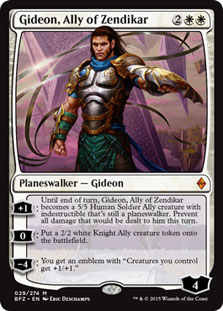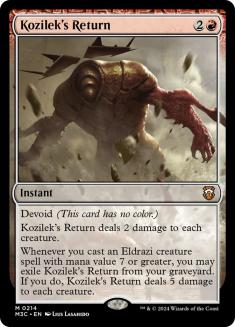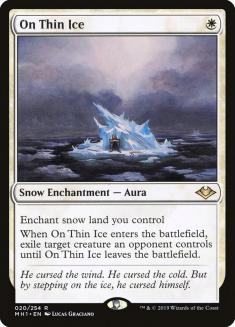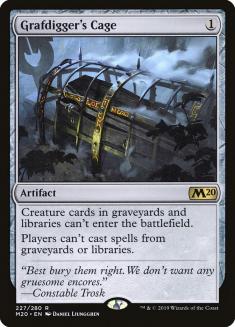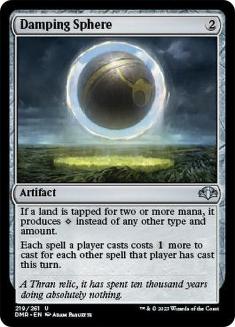With the recent bans, Modern is a whole new format. Uro, Titan of Nature’s Wrath and Field of the Dead have largely dominated the metagame for the last year, and without them it feels like there’s plenty of room for decks, both old and new, to compete.
But that doesn’t mean that the metagame is completely wide open. There are already key trends developing and top decks emerging, and if you’re going to have success you need to be prepared for them. Modern has long been the format where sideboard construction is most important.
This is in part because the sideboard cards are so powerful, but also because the metagame is typically diverse enough that it’s very difficult to find enough space to properly prepare for every archetype. So there’s some tension between playing the most impactful sideboard cards in high numbers and diversifying your sideboard so you can be ready for a broad spectrum of decks.
Today, I’ll list five cards that you should strongly consider for your sideboards this weekend because they are particularly high-impact in certain matchups, can help against a variety of matchups, or both. In no particular order, here they are.
1. Gideon, Ally of Zendikar
I mentioned Uro and Field of the Dead as dominant cards for the last year, and part of why these cards have been so dominant is their ability to dominate the long-game without ever mucking up the early-game. These cards created inevitability for the lowest cost we’ve ever seen, so the rest of the metagame was forced to beat them in the early-game and only the early-game.
Without these cards, control decks are still having success, but the template is similar to what we saw in 2018 and before. It’s an Azorius base with some counterspells, removal, sweepers, and primarily planeswalkers that take over the game. As an aggro deck, one of the keys to beating a matchup like this is to punish them for when they cast their sweeper. That’s what Gideon, Ally of Zendikar does. They’re unlikely to leave in Force of Negation against an aggressive strategy so I wouldn’t worry about that, and having a threat that isn’t easily removed but still demands an answer is exactly what you want.
Gideon was completely held in check by Uro and Field, since those cards simply rendered it irrelevant on the battlefield. Uro pressured the Gideon itself while the lifegain made it impossible to race back, and the horde of Zombies from even a single Field eventually dwarfed the tokens from Gideon due to various ramp spells and fetchlands. Now it’s back to dominating games because it’s so hard to pressure from most control decks.
So for decks like Death & Taxes or midrange Stoneblade strategies, I’d strongly consider one or two copies of Gideon as part of your plan against opposing control decks as well as midrange mirrors, where having individually powerful cards is so important. And if you’re playing a similar strategy outside of white, there are plenty of similar cards that play the same role, mostly planeswalkers like Chandra, Torch of Defiance, but also sticky threats like Thrun, the Last Troll. You don’t have to put your head down and play a recklessly aggressive gameplan against control now that they don’t have nearly as powerful of a late-game.
2. Kozilek’s Return
This one has already started to be adopted in Monastery Swiftspear decks, and at this point it should be universal and in high numbers because the bane of every Monastery Swiftspear deck is Auriok Champion. Champion has long been a staple sideboard card of white creature decks from Humans to Death & Taxes, and now that it’s also a maindeck card in Selesnya Company, it’s among the most-played creatures in the entire Modern format.
If you’re going to play a Monastery Swiftspear deck, whether it’s Rakdos Death’s Shadow (Lurrus), Izzet Prowess, or another, you absolutely must be well-prepared to answer Auriok Champion. Kozilek’s Return is the best answer available, since it conveniently doesn’t kill your own prowess creatures while removing every copy of Auriok Champion as well as creatures like Arbor Elf, Meddling Mage, and Skyclave Apparition. It’s a complete haymaker that you want to draw nearly every game in a variety of matchups.
The one card you do have to worry about is Giver of Runes, which can grant protection from colorless to a key creature like Auriok Champion. Fortunately, Giver doesn’t protect itself, so it’s an easy target for your other spot removal, but it’s one to be aware of when you’re setting up for a devastating Kozilek’s Return so you don’t get caught unprepared.
Right now, nearly every non-Burn Monastery Swiftspear deck sideboards two copies of Kozilek’s Return. And while I sympathize with the reticence to stack your Modern sideboard with a single card because you want to be prepared for the wide variety of decks the metagame presents, there are more than enough copies of Auriok Champion around to play three or four copies of your best answer to it. The book on combating Swiftspear decks has been written, and it won’t change until you force it to.
3. On Thin Ice
When it comes to removal spells in Modern, the top tier consists of the three most powerful one-mana options: Lightning Bolt, Fatal Push, and Path to Exile. These are among the most-played cards in the format and while the balance of power between them is continuously shifting, none of them are going anywhere.
But if you’re relying on a single one of these spells as the basis of your removal suite, you need to be aware of which threats you’re going to be most vulnerable to and prepare your sideboard accordingly. The weakness of Lightning Bolt against bigger creatures and Fatal Push against more expensive creatures is clear, but Path to Exile looks like it leaves you with no weaknesses. However, when you play with Path to Exile, it’s clear that this is not a removal spell you want to cast in the early-game, since the land you give your opponent snowballs into a significant tempo advantage.
So, if you’re playing a deck that relies on Path to Exile, your weakness is to Monastery Swiftspear and other one-mana threats. On Thin Ice is a great option for these decks to cleanly answer early creatures without giving up a significant tempo advantage or being forced to splash another color to gain access to other options like Lightning Bolt and Fatal Push.
Now, On Thin Ice isn’t appropriate for every list, since you need access to early snow lands in order for it to be castable. But between fetchlands and basics, there are plenty of decks where switching to snow lands alone will be enough to cast On Thin Ice reliably. Decks like Azorius Control, Death & Taxes, and Bant Stoneblade are prime candidates. Conveniently, these are all decks that will want to have cheap answers to early creatures since they want to maintain parity in the early-game before taking over with more powerful cards or disrupting their opponent’s ability to cast spells in the mid-game.
With the popularity of Monastery Swiftspear at an all-time high, it’s essential that decks relying on Path to Exile have a better early answer to creatures in their sideboard, and On Thin Ice is the best option.
4. Grafdigger’s Cage
One of the decks that was heavily suppressed by Uro and friends that you may not expect was Dredge. Without Faithless Looting, Dredge has slowed significantly, and that makes it much more important to leverage its ability to grind out games with recursive threats. But the power of Uro, Field of the Dead, and Mystic Sanctuary rendered threats like Prized Amalgam and Bloodghast irrelevant, no matter how often they came back.
We’ve already seen a resurgence in Dredge and the deck is having success because sideboards haven’t adjusted to the new reality that hard graveyard hate is once again something many decks will need access to.
My colleague Ari Lax dismissed Dredge in his article earlier this week as a worse version of Oops All Spells, but to me they are completely different decks. Dredge prides itself on resilience and its ability to render traditional means of interaction irrelevant. Oops All Spells is much more all-in and thus much more vulnerable to a single Thoughtseize or counterspell. So while I think most decks can handle Oops All Spells via traditional means, unless you have a naturally good matchup against Dredge by trumping them on the battlefield a la Uro, you’re going to need some effective graveyard hate.
I chose to highlight Grafdigger’s Cage specifically for this role for three reasons. First, it’s playable in every deck, though obviously if it significantly impacts your own gameplan then you should look for a better option. Second, it costing one mana is important because you can cast it before your Dredge opponent gets to Cathartic Reunion mana, even in games where you play second. And third, it has a secondary application against Selesnya Company since it shuts down Collected Company.
I wouldn’t want to bring in too many copies because that application is so narrow, but the first has value. Moreover, I’ve always advocated for diversifying your graveyard hate cards against a deck like Dredge to make it harder for them to counter your hate with their own sideboard. I would strongly consider incorporating Grafdigger’s Cage as part of your anti-graveyard package for this weekend, because Dredge doesn’t go away until the metagame forces it down.
5. Damping Sphere
In the previous metagame, the big mana section was dominated by Primeval Titan. But losing Field of the Dead is a huge blow to those decks, and that along with a powering down of blue decks has paved the way for a return of Urzatron decks. Mono-Green Tron, in particular, has once again established itself as a player after months of laying dormant.
Regardless of your feelings about Urza’s Tower, it’s now imperative to prepare for these decks once again, and that means the return of Damping Spheres. Like Grafdigger’s Cage, Damping Sphere is playable in any deck, and importantly it is castable before your opponent gets to Turn 3, the critical turn for assembling Urzatron. Some decks like Izzet Prowess may prefer something like Cleansing Wildfire that doesn’t disrupt their own gameplan, but Damping Sphere is always where you start when it comes to Tron hate.
Preparing for Tron decks is going to be especially important for midrange players who are excited to explore non-Simic options now that Uro isn’t simply better than the rest, and those decks are notoriously bad against Karn Liberated. Tron players have been lying in wait for this moment and you have to come prepared in order to beat them.
I’m also high on Damping Sphere as a hate card because, while the immediate tournament results show a precipitous decline in Primeval Titans, the card is too powerful to stay down for long. And while Field of the Dead was an integral part of the more fair Titan decks, Amulet Titan can contend without it. So I expect Amulet Titan to once again be the Primeval Titan deck of choice, and Damping Sphere shutting down the bouncelands makes it a solid piece of disruption in the matchup. It’s time to trade in those Aether Gusts for something a bit better-rounded.
Moving Forward
It’s tempting to treat a wide-open metagame as an invitation to take it easy when it comes to crafting your sideboard and rely on a wide range of generic cards rather than building for an expected metagame. But even in times of flux like this, there are trends you can take advantage of. The prevalence of Monastery Swiftspear and Auriok Champion as well as the return of Dredge and Mono-Green Tron are among the trends we see right now in Modern that should guide your sideboard building.
You’ll still want to prepare for the unknown element that has been Modern’s hallmark before Uro, but it’s about finding the right balance between preparing for the expected and the unexpected. And that balancing act is one of the things that separates the good from the great. I’d seriously consider all five cards I listed for this weekend, but it’s important to make sure they’re being used as part of a plan that coheres with your deck’s strategy.


